You've probably already heard about the famous blockchain technology trilemma: scalability, speed, and security. Many of the current Layer 1 blockchains solve two of them to a greater or lesser extent. Satisfying all three requirements simultaneously is complex, and even more so when you do it while trying to keep costs down.
I've never liked to start at the end, but this time I'm going to make an exception. The Internet Computer not only solves the problems I have mentioned. It adds innovative concepts and ideas that will change the internet as we know it.
This article compares some of the main features of the Internet Computer with the following layer one blockchains: Ethereum, Cardano, Solana, Binance Smart Chain, Zilliqa, Algorand, and Avalanche. Although Polkadot is a 0-layer blockchain, known as a multi-chain protocol with heterogeneous sharding, I thought it would be interesting to include it in this analysis.
1. Comparison between the Internet Computer VS Layer 1 Blockchains
The main innovation behind the Internet Computer is Chain Key Technology, which encompasses several new technologies, including the consensus mechanism, Non-Interactive Distributed Key Generation (NI-DKG), Network Nervous System (NNS), Internet Identity, and more.
Other blockchains add changes that improve some of the features that Ethereum offers, such as the speed or fees. Still, the Internet Computer presents innovative changes in all the bases that will transform the existing technology.
Without further ado, let's look at some differences that this technology offers.
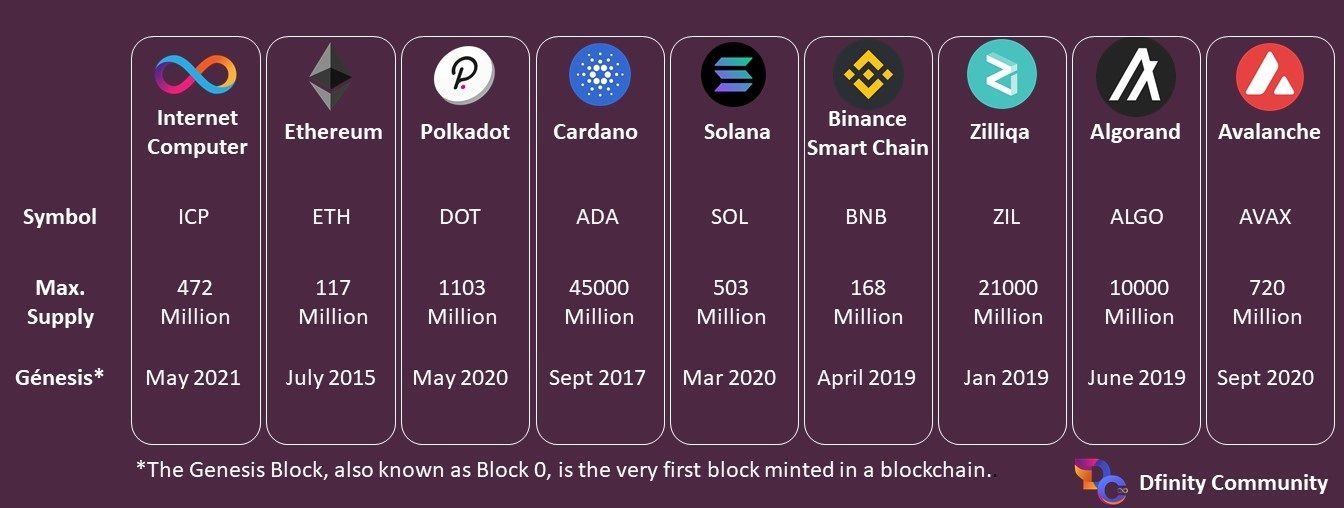
The Current Supply of $ICP is 472 Million, and the inflation starts at 10% and then stabilizes at 5% over the years. Cycles burning to power the dapps will increasingly drive deflation as the number of daily active users rises.
1.1. Consensus Mechanism

The purpose of a consensus mechanism is to verify that the information added to the ledger is valid. This ensures that the following block to be added is represented correctly and all transactions in the network are updated. This prevents double-spending or invalid data from being recorded.
Proof-of-Work (PoW), the most popular consensus protocol in cryptocurrency, first came into play with the invention of Bitcoin. Ethereum adopted the same mechanism, although an upgrade to Proof-of-Stake (PoS) has long been in the works.
Many other blockchains copied the original Bitcoin code and, as such, also use the Proof-of-Work model.
Although Proof of Work is an amazing invention, it is anything but perfect. Not only does it need significant amounts of electricity, but it is also very limited in the number of transactions it can process at the same time.
Proof-of-Stake (PoS) was created as an alternative to Proof-of-Work, to address the various problems associated with the latter. The main advantages of Proof-of-Stake are that it reduces the vast expenditure of electrical power to secure a blockchain and improves the speed of creating each block, which is done in seconds. (milliseconds in the case of Solana, but still 10x slower than the Internet Computer).
Solana, Binance Smart Chain, and Avalanche use the Proof of Stake consensus mechanism. Other blockchains use Proof of Stake based consensus algorithms such as:
Zilliqa employs Practical Byzantine Fault Tolerance protocol (PBFT) in combination with Proof-of-Work. PBFT runs under the assumption that up to 1/3 of the nodes in each shard before starting the protocol can be malicious.
Internet Computer uses Threshold Relay consensus, a heavily optimized version of the Proof-of-Stake (PoS) model. It emphasizes transaction finality by implementing a Threshold Relay technique in conjunction with the BLS signature scheme and a notarization method to address many problems associated with PoS consensus.
In the Internet Computer version, nodes produce a random number, called a "random beacon," which is used to select the next group of nodes and drive the platform's protocols.
1.2. Speed
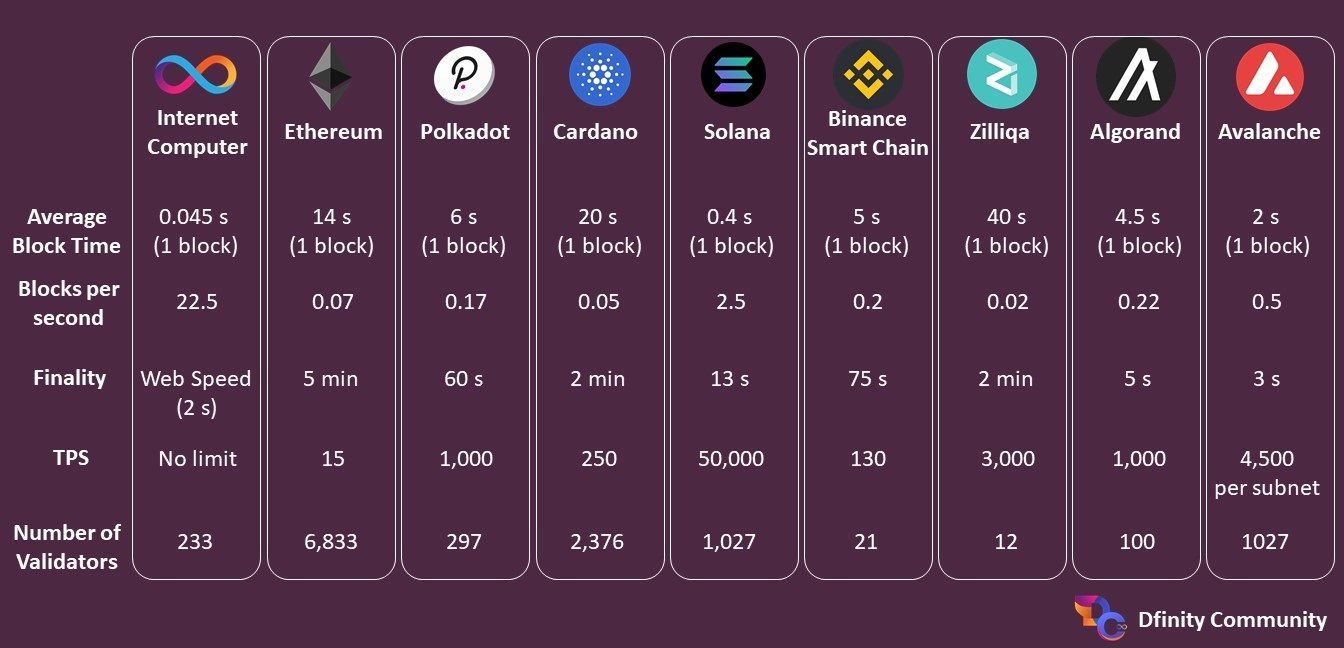
In the race for the blockchain podium, the parameters most claimed by blockchain enthusiasts are those related to speed. Unlike security or scalability, speed has measurable parameters that make it easier to rank the winners.
The transaction speed is calculated using three metrics:
- Block Size: The amount of data (in bytes) that can be contained in a single block.
- Block Time: Time needed to create the next block in a blockchain.
- Average Transaction Size: How large the average transaction on the blockchain network tends to be.
Often, performing this calculation can be complicated by the fact that some blockchains, such as Ethereum, have been gradually increasing the size of their blocks over the years to accommodate transaction demand.
The speed of a blockchain network directly impacts the time it takes the end-user to make a transaction from one account to another. This time is measured by the "Transaction Finality" parameter, which indicates the amount of time we have to wait to guarantee that cryptocurrency transactions cannot be altered, reversed, or canceled after they are completed.
In order to position themselves in the market, some blockchains often use "Block Time" to refer to "Transaction Finality." The former does not consider parameters such as latency (the amount of time it takes for a blockchain network to confirm a transaction), which is included in the "Transaction Finality." The actual speed of a blockchain is checked here.
The last key metric I will mention is the TPS.
Transactions Per Second refers to the number of transactions that a network is capable of processing each Second. This is only a theoretical number calculated as transactions per block, divided by block time.
Solana has aggressively promoted itself on a supposedly high transaction volume and low Block Time.
Solana's Block Time is indeed fast (it is the best after the Internet Computer), but this is very different from the Transaction Finality. It usually takes several blocks before the transaction is included in a block and committed to a consensus state. Solana uses "Optimistic Confirmation" that requires 32 votes; thereby, the "Transaction Finality" is about 13 seconds.
Additionally, Solana uses Proof of History as a tool in its Proof of Stake consensus. This technical innovation addresses a problem that other blockchains don't even have to begin with. Namely, blocks must be produced serially, so Proof of History introduces a verifiable delay to synchronize the timing of block production.
Algorand and Avalanche are the other two projects that deserve to be mentioned in this section.
Although neither has a better block time than Solana, they improve the Transaction Finality time. Therefore, we can state that, after the Internet computer, the blockchain with the best speed data is Avalanche. All the other blockchains not mentioned in this paragraph still have a lot of work ahead of them if they want to improve these records, if indeed they can.
The Internet Computer uses its innovative Chain Key technology to finalize transactions that update smart contract states in 1–2 seconds. If you look at this prestigious study on tolerable waiting time, Miller considers that an individual perceives awaiting awareness after approximately 2 seconds.
Specific applications such as online games require that responses be provided to users in milliseconds.
The Internet Computer solves this by splitting smart contract function execution into two types, known as "update calls" and "query calls."
- Update calls are those we are already familiar with and take 1–2 seconds to finalize their execution.
- Query calls work differently because any changes they make to state (in this case, the memory pages of canisters) are discarded after they run.
Essentially, this allows query calls to execute in milliseconds.
Furthermore, at Genesis, the "Network Nervous System" subnet was launched with 28 nodes, and the application subnets have 7 nodes each. The Network Nervous System, which is governed by the votes of the neuron holders, decides the size of a given subnet. In the Internet computer, subnets are blockchains that Chain Key cryptography combines into a single blockchain.
The Internet Computer continues to grow exponentially, with 4,300 nodes planned by the end of the year, so the transactions per second (TPS) of a single subnet will be multiplied by the number of subnets created. For this reason, there is no limit to how far TPS can go.
If you wish to consult the current data of the table above, please visit the following links: Internet Computer, Ethereum, Polkadot, Cardano, Solana, BSC, Zilliqa, Algorand and Avalanche.
1.3. Scalability options

The scalability of blockchain networks is the ability to support high transaction throughput and future growth. This means that as the adoption of blockchain technology accelerates, the performance of a scalable blockchain will not be affected.
Bitcoin and Ethereum are Tormented by Scaling issues
Bitcoin and Ethereum have suffered from scalability issues over the past few years due to the limitation of the Proof of Work consensus model. Currently, Ethereum can leverage the Layer 2 solutions to overcome scalability issues, but the nodes run on big tech cloud platforms such as Amazon Web Services (AWS), thus sacrificing decentralization.
Ethereum also plans to migrate from Proof of Work to Proof of Stake in its future update called "London." This update will allow it to improve the capacity and scalability of this blockchain with 64 shard chains (Ethereum 2.0 will spread the network load across 64 separate shards, with one Beacon Chain to rule them all). These shards will give Ethereum more capacity to store and access data, but they won't be used for executing code.
Like Ethereum 2.0, Polkadot also has a main chain, called the Relay Chain, with several shards called parachains. The number of parachains is limited and is currently estimated at about 100. As I mentioned in the previous section, subnets in the Internet Computer are blockchains that Chain Key technology combines into a single blockchain that increases its capacity with demand (unbounded capacity) and provides a roadmap to infinite scalability. The number of subnets is unlimited.
On the other hand, Binance Smart Chain achieves scalability by sacrificing decentralization.
In its consensus model, it uses only 21 validators (Proof of Authority) which, in my view, makes it the most centralized blockchain. In the meantime, Cardano is still waiting for Hydra, its layer 2 solutions, and the same solution that Matic (Polygon) has been offering Ethereum for quite some time now.
Hey there Solana. We didn't forget you
Like how Bitcoin and Ethereum sacrificed scalability, Solana sacrificed decentralization. Its "innovative" Proof of History (PoH) adds a new problem that does not exist in other blockchains. Every day, this protocol creates a tremendous amount of transaction history data that needs to be stored (more than 2 TeraBytes per year).
Its size is even more significant than the total data accumulated by the top ten blockchain networks combined. Solana stores this immense amount of data in Arweave (a decentralized storage network) so that its validators only store data from the last two days.
In this way, Solana puts transaction history in the hands of other chains governed by another community.
In addition, Solana's scalability is in the spotlight. Recently, it stumbled after the blockchain network suffered an outage for more than 17 hours. The network could not cope with a surge in activity, a problem Solana called "resource exhaustion." Besides, this is not the first time it has experienced downtime, and the same network went down for about six hours in December 2020.
Finally, I will focus on Avalanche and Algorand
Avalanche network is a platform built by three compatible blockchains: the Exchange Chain (X-Chain), Platform Chain (P-Chain), and Contract Chain (C-Chain). Each subnet, managed on the P-Chain, operates as a mini-network, and all mini networks join to make the broader Avalanche network. Therefore, scalability will depend on the number of subnets.
The downside is that Avalanche (and Algorand) do not offer their own data storage service. In this case, they do not utilize it to store transaction history, like Solana. They use this decentralized service to share files and store data. Algorand uses the Interplanetary File System (IPFS), and Avalanche uses both Arweave (through Kyve network) and Ceramic. Code and data live together on-chain on the Internet Computer, which is another significant advantage of scalability.
1.4. Transaction Fee

Transaction fees reward miners (Proof of Work) or validators (Proof of Stake) who help confirm transactions.
While Bitcoin fees depend on the size of the transaction in bytes (not to be confused with the number of tokens sent), Ethereum transaction fees take into account the amount of computing power needed to process a transaction, known as gas, which also has a variable price measured in ETH and is directly related to network traffic.
The Binance Smart Chain (BSC) transaction fee is similar to the one proposed by Ethereum. It is not strange because, from my point of view, BSC is a copy of Ethereum. They have changed the consensus model to improve some limitations of the latter (and it must also be said, to worsen others such as decentralization).
Finally, other blockchains such as Algorand and the Internet Computer offer a fixed fee that depends on the value of their token (0.001 ALGO and 0.0001 ICP, respectively).
1.5. Smart Contracts
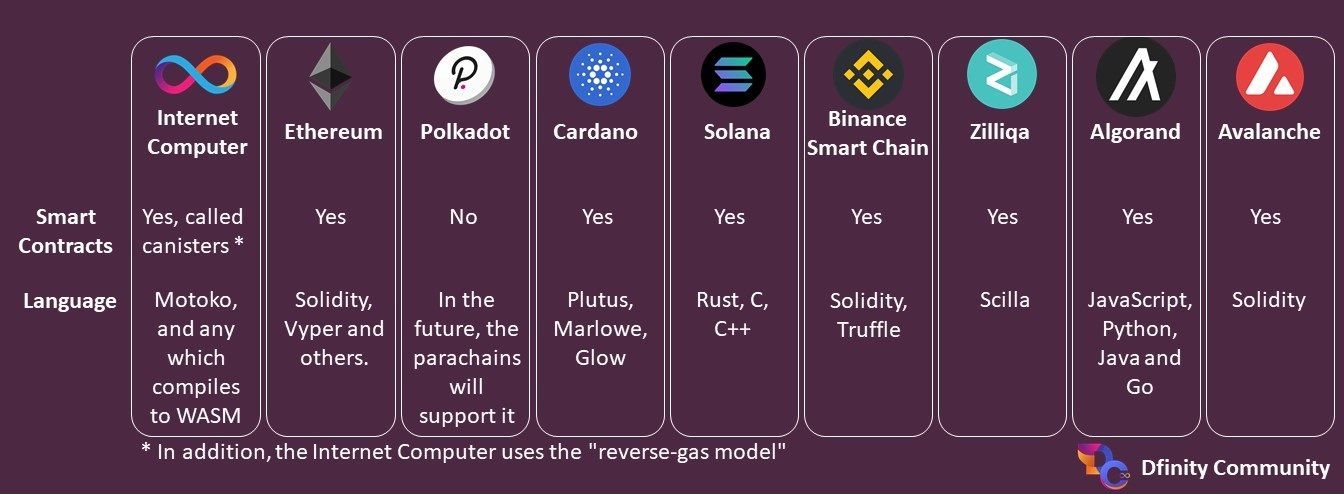
Blockchain ecosystems evolve at a different pace. For some, it can be months between essential updates, while others have a higher pace, such as the Internet Computer, which has seen major developments recently.
Since Ethereum launched its first Smart Contract in 2015, other blockchains have followed suit. A clear example is Cardano that recently, through its "Alonzo Hard Fork," has managed to create its first Smart Contract to offer the same service without improvements.
Internet Computer Smart Contracts are called Canisters because they're a bundle of WASM code and Memory Pages, and they are an evolution and specialization of Smart Contracts. Their significant increase in numbers speaks to the growing activity of developers on the network:
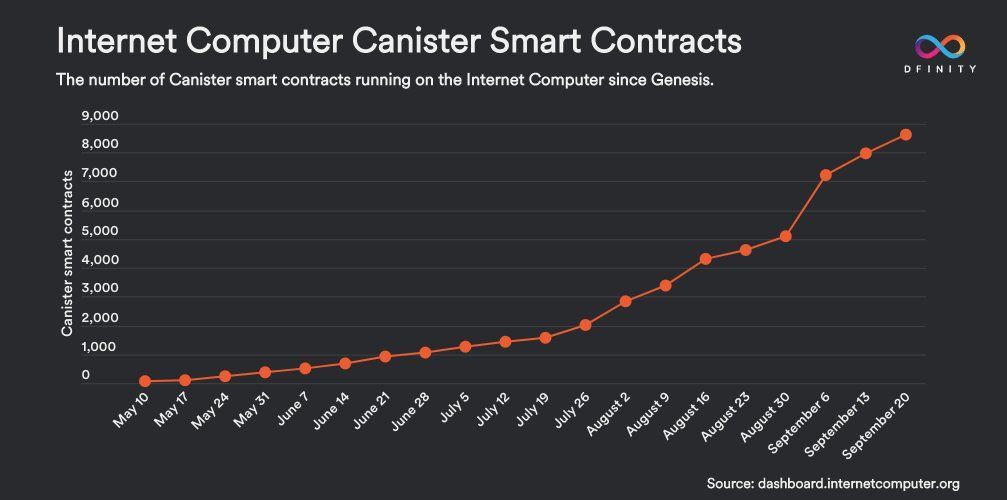
Canisters remove bottlenecks using "Orthogonal Persistence," which eliminates the need to maintain and manage external databases or storage volumes (code and data live together on-chain). Other blockchains need to keep their data on other decentralized storage networks (it adds a problem having two different trust domains, in addition to the complexity).
Smart Contracts will rule the world
The Internet Computer community has also approved a proposal to increase the capacity of Canisters from 4GB to 300GB. Very few applications would need more capacity, but you can build your service/system from as many contracts as you need if this is the case.

In addition, an interface description language called Candid allows canisters to interact with each other regardless of the programming language in which they were developed.
While Cardano is still looking at its first smart contract, the Internet Computer already has a date for its next target
Internet Computer will add Smart Contracts to Bitcoin by the end of this year. It is possible through an application of Chain Key cryptography that will directly integrate the networks. Smart contracts on the Internet Computer will be able to hold, send and receive bitcoin without the need for private keys.
These Bitcoin smart contracts will run as regular canisters on the Internet Computer so that you will save a lot of money in transaction fees.
In Ethereum, developers pay to deploy smart contracts, and people pay to use them. The Internet Computer uses a "reverse gas model" where only developers supply the funds needed to run the applications/contracts that use their gas (called "cycles"). Furthermore, on Ethereum, 1GB costs about $5,000,000, and on the Internet Computer, 1GB costs about $3-5.
In short, Canisters are Smart Contracts without limitations that enable the reimagination of everything such as interactive web and dApps on chain (Blockchain Singularity) instead of Big Tech Clouds like AWS, Google, Azure, etc.
1.6. Digital Identity Management
The Internet Computer brings a whole new meaning to Identity management through its novel Internet Identity (II) System. This Advanced blockchain authentication guarantees that your data isn't visible tracked, or mined. It enables you to authenticate securely and anonymously when you access decentralized applications (dApps) that use the authentication system.
Authenticate to services using fingerprint sensor, Face ID, YubiKey, and more.
Internet Identity is being constantly refined to make it compatible with more and more devices. Currently, it also supports Windows Hello as an authentication method. The following guide explains how to set up authentication for an existing Identity Anchor that was set up either on your phone or using a security key.
In other blockchains such as Ethereum, users need external wallets like Metamask to interact with decentralized applications. Below you can see the difference between Ethereum and the Internet Computer.
Dapps on Internet Computer:
- Create an Identity.
- Go to a website and use a Dapp for free.
- Or you can use IC native Wallets to authorize - Stoic wallet and Plug Wallet
Dapps on Ethereum:
- Download Metamask wallet.
- Go to an exchange, create an account, buy Ethereum.
- Send ETH to Metamask.
- Go to a website, login into Metamask, use a Dapp by paying with ETH.
At the time of writing, Internet Identity reached more than 1.17 million accounts in 4 months. One word - Revolutionary!
1.7. On-Chain Governance / Voting / Proposals

The Internet Computer uses an algorithmic governance system called the Network Nervous System (NNS) that allows ICP holders to lock tokens within it to create "neurons." These neurons provide voting rights on proposals like this one which affects the network's operation and gives participants rewards in the form of additional ICP tokens.
The network's community actively directs the effort to make the network more efficient, faster, and easier for developers. Technical upgrades are subject to community discussion, voting, and approval via motion proposals to the Network Nervous System.
Of all the blockchains proposed in this article, only Polkadot and Avalanche have a governance system, although in the case of Avalanche, only for critical network parameters (which means that it underestimates the decision-making power of its community). Only a predetermined number of parameters can be modified via governance, such as the minimum staking amount, minting rate, and other economic parameters.
In addition, Algorand's governance system is still under development, although it is expected to be operational as of next October.
1.8. Staking Rewards

Staking is the process of delegating or locking up crypto holdings to earn rewards. Once you have staked your assets, you can earn staking rewards on top of your holdings and grow them further by compounding those future rewards.
As you can see in the table above, the Internet Computer offers the highest return, ranging from 15.4% per year for 6-month staking to 28.9% per year for 8-year staking.
Consult the ICP Neuron Calculator to determine the returns you will obtain according to your objectives. The following guide provides you a step-by-step explanation of how to stake ICP tokens using the Network Nervous System (NNS).
2. Other Blockchains
In addition to the Blockchains seen in the previous sections, the following podcast reviews others such as Skale, Cosmos, or Mina. In this episode, the Internet Computer Report team expresses their unfiltered opinions on how they compare to the Internet Computer.
If you are particularly interested in any of them, check the timestamp for direct access to the minute you want.
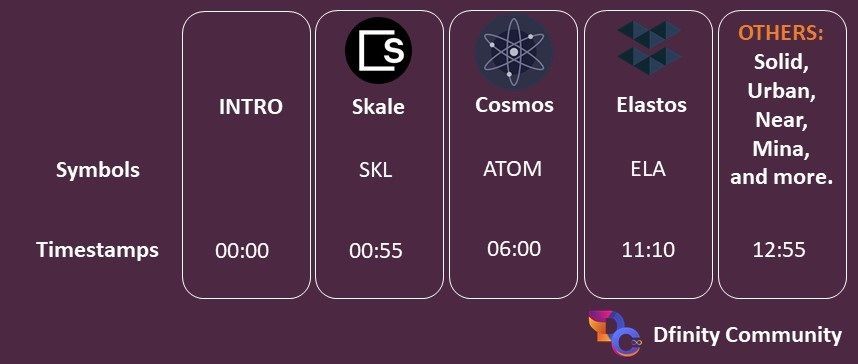
3. Conclusion
I believe that many of the blockchains mentioned in this article will coexist for the next few years. Thereafter, those that bring the most advances and solutions to blockchain technology will remain.
The Internet computer is the newcomer, offering the world a new paradigm and technology with revolutionary near-term goals such as the integration of Bitcoin and Ethereum.
It is the fastest blockchain with a finality time of 2 seconds and a query call of 100 ms. Its canister smart contracts offer a real web 3.0 serving the web and interacting directly with users. Scalability is unlimited, and it provides a highly adaptable blockchain that allows its community to vote on proposals through the Network Nervous System to manage the Internet Computer. These are just some of its innovative and robust features!
At this point, you have to decide: do you settle for the Lambo steering wheel, or do you prefer the complete car?
Official DFINITY Channels:
Website | Twitter | Youtube | Medium | Github | Telegram | Reddit | Facebook | Instagram | LinkedIn | Forum | Discord | The Reboot
Connect With Us:
Twitter | Telegram | Instagram | Facebook | Email
ICP Squad Discord: discord.gg/icpsquad
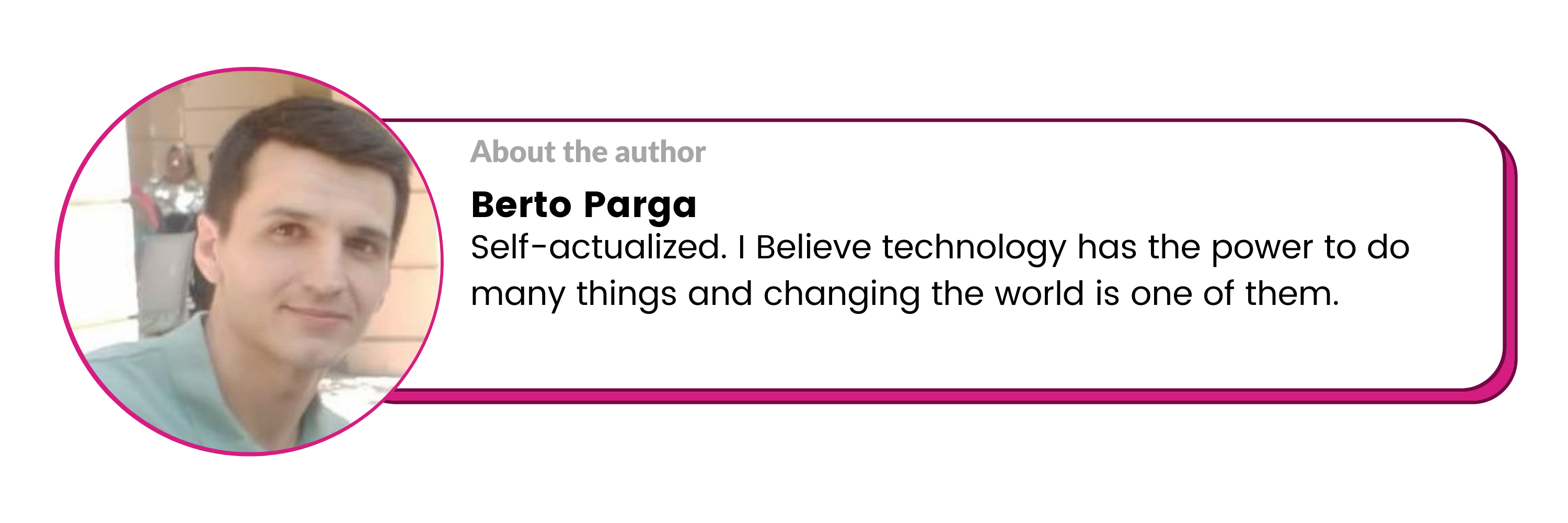
- Disclaimer: The views and opinions expressed on this website are solely those of the original author and other contributors. These views and opinions do not necessarily represent those of the Dfinity Community staff and/or any/all contributors to this site.

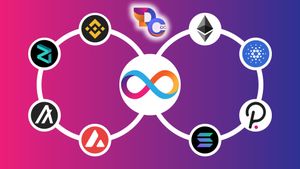

Comments are for members only. Join the conversation by subscribing 👇.